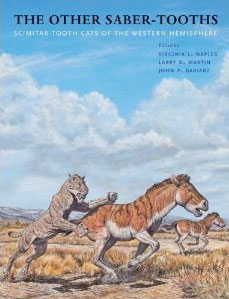The Other Saber-Tooths: Scimitar-Tooth Cats of the Western Hemisphere
PE Review Number 16.1.1R
Published May 2012
Author biography
PDF version
{flike id=365}
Virginia L. Naples, Larry D. Marin and John P. Babiarz
The Johns Hopkins University Press, 2011
252 pp., $110.00 (hardback)
ISBN 13: 978-0801896644
While saber-tooth cats capture the imagination of children and adults alike, most of what we know about saber-tooth cats comes from the large number of fossils from Smilodon fatalis, a dirk-tooth sabercat. The Other Saber-Tooths was written to focus on the less well-known scimitar-tooth cats of the western hemisphere, a well-deserved topic, since the scimitar-tooth cats have received less attention by scientists - the editors of this book excluded - and almost no attention in the popular media. When I looked through this book the first thing I noticed was the wonderful artwork. Mark Hallett illustrated much of this book and his art is outstanding. Hallett’s contribution makes this book a work of art. This book covers many topics focused on scimitar-toothed cats, such as how the teeth were used, osteology, and phylogeny of this interesting group of extinct animals. As a large carnivore biologist I was very excited to see this book published.
 The introduction was well-written and went through the background information necessary to understand the differences between the dirk-tooth and the scimitar-tooth sabercats. Chapter two, which is about experimental paleontology of dirk-tooth and saber-tooth bites, gives a good overview on the different killing styles of different types of cats (both extant and extinct) and what has been done in the past, but makes little new contributions itself. One would be better served by reading the cited papers in chapter two. Chapter three, which focuses on pathology in saber-tooth cats, focuses almost entirely on Smilodon fatalis, not the scimitar-toothed cats. There are few specimens of scimitar-toothed cats available for study, and even fewer pathological specimens, so it is understandable why there is a dearth of scimitar-tooth pathology here. However, given the theme of the book, it seems that this chapter should have focused solely on the scimitar-toothed cats. Chapters four and five add to our knowledge about the “cookie-cutter” cat, Xenosmilus hodsonae and give insight into how this massive cat may have looked and lived. Chapter six has been a long-awaited chapter, personally, for this researcher. It is a complete description of the osteology and myology of a new species of Homotherium from Idaho, Homotherium ischyrus. This almost complete specimen of Homotherium is a valuable resource for paleontologists and I am very pleased that Jonena Hearst, and co-authors have contributed to this volume with its description. The final three chapters deal with the phylogenetics of the Homotherinii, which is certainly a welcome addition to the field of paleontology and the evolutionary history of cats.
The introduction was well-written and went through the background information necessary to understand the differences between the dirk-tooth and the scimitar-tooth sabercats. Chapter two, which is about experimental paleontology of dirk-tooth and saber-tooth bites, gives a good overview on the different killing styles of different types of cats (both extant and extinct) and what has been done in the past, but makes little new contributions itself. One would be better served by reading the cited papers in chapter two. Chapter three, which focuses on pathology in saber-tooth cats, focuses almost entirely on Smilodon fatalis, not the scimitar-toothed cats. There are few specimens of scimitar-toothed cats available for study, and even fewer pathological specimens, so it is understandable why there is a dearth of scimitar-tooth pathology here. However, given the theme of the book, it seems that this chapter should have focused solely on the scimitar-toothed cats. Chapters four and five add to our knowledge about the “cookie-cutter” cat, Xenosmilus hodsonae and give insight into how this massive cat may have looked and lived. Chapter six has been a long-awaited chapter, personally, for this researcher. It is a complete description of the osteology and myology of a new species of Homotherium from Idaho, Homotherium ischyrus. This almost complete specimen of Homotherium is a valuable resource for paleontologists and I am very pleased that Jonena Hearst, and co-authors have contributed to this volume with its description. The final three chapters deal with the phylogenetics of the Homotherinii, which is certainly a welcome addition to the field of paleontology and the evolutionary history of cats.
This book was an interesting and fun read, but one question I had was, “who is the intended audience”? The book includes a glossary of terms, which seems intended for a non-technical audience. Chapters two and three are low on new findings and have a writing style that seems to be geared toward non-paleo folks. This is in contrast to the latter chapters, which seem to be written for a more professional paleontological audience, including a systematic species description. Finally, the book could have benefitted from the contributions of a wider selection of experts in the field. Nevertheless, this book is a highly beneficial contribution to science, and also looks very nice displayed prominently on the coffee table.


